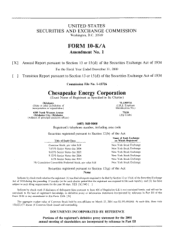Chesapeake Energy 2000 Annual Report Download - page 20
Download and view the complete annual report
Please find page 20 of the 2000 Chesapeake Energy annual report below. You can navigate through the pages in the report by either clicking on the pages listed below, or by using the keyword search tool below to find specific information within the annual report.
depends on our future performance. General economic conditions, oil and gas prices and financial, business
and other factors affect our operations and our future performance. Many of these factors are beyond our
control. We cannot assure you that we will be able to generate sufficient cash flow to pay the interest on our
debt or that future working capital, borrowings or equity financing will be available to pay or refinance such
debt. Factors that will affect our ability to raise cash through an offering of our capital stock or a refinancing of
our debt include financial market conditions and the value of our assets and our performance at the time we
need capital.
In addition, our bank borrowing base is subject to semi-annual redeterminations. We could be forced to
repay a portion of our bank borrowings due to redeterminations of our borrowing base. We cannot assure you
that we will have sufficient funds to make such repayments. If we do not have sufficient funds and are
otherwise unable to negotiate renewals of our borrowings or arrange new financing, we may have to sell
significant assets. Any such sale could have a material adverse effect on our business and financial results.
Higher oil and gas prices adversely affect the cost and availability of drilling and production services.
Higher oil and gas prices, such as those we are currently experiencing, generally stimulate increased
demand and result in increased prices for drilling rigs, crews and associated supplies, equipment and services.
We have recently experienced significantly higher costs for drilling rigs and other related services and expect
such costs to continue to escalate in 2001.
Our industry is extremely competitive.
The energy industry is extremely competitive. This is especially true with regard to exploration for, and
development and production of, new sources of oil and natural gas. As an independent producer of oil and
natural gas, we frequently compete against companies that are larger and financially stronger in acquiring
properties suitable for exploration, in contracting for drilling equipment and other services and in securing
trained personnel.
Our commodity price risk management activities have reduced the realized prices received for our oil and gas
sales and these transactions may limit our realized oil and gas sales prices in the future.
In order to manage our exposure to price volatility in marketing our oil and gas, we enter into oil and gas
price risk management arrangements for a portion of our expected production. These transactions are limited
in life. While intended to reduce the effects of volatile oil and gas prices, commodity price risk management
transactions may limit the prices we actually realize. In 2000, we recorded reductions to oil and gas revenues
of $30.6 million related to commodity price risk management activities. We cannot assure you that we will not
experience additional reductions to oil and gas revenues from our commodity price risk management. If the
hedges in existence at December 31, 2000 had been settled on that date, based upon futures prices as of that
date, we would have incurred a loss of $89.3 million, which would have been recognized as price adjustments
during the related months of future production. In addition, our commodity price risk management
transactions may expose us to the risk of financial loss in certain circumstances, including instances in which:
our production is less than expected,
there is a widening of price differentials between delivery points for our production and the
delivery point assumed in the hedge arrangement, or
the counterparties to our contracts fail to perform the contracts.
Some of our commodity price risk management arrangements require us to deliver cash collateral or
other assurances of performance to the counterparties in the event that our payment obligations with respect to
our commodity price risk management transactions exceed certain levels. Our collateral requirement for these
activities at December 31, 2000 was $35 million, consisting of $31.5 million in letters of credit and $3.5 million
in cash deposits. Future collateral requirements are uncertain, but will depend on arrangements with our
counterparties and highly volatile natural gas and oil prices.
-9-
























